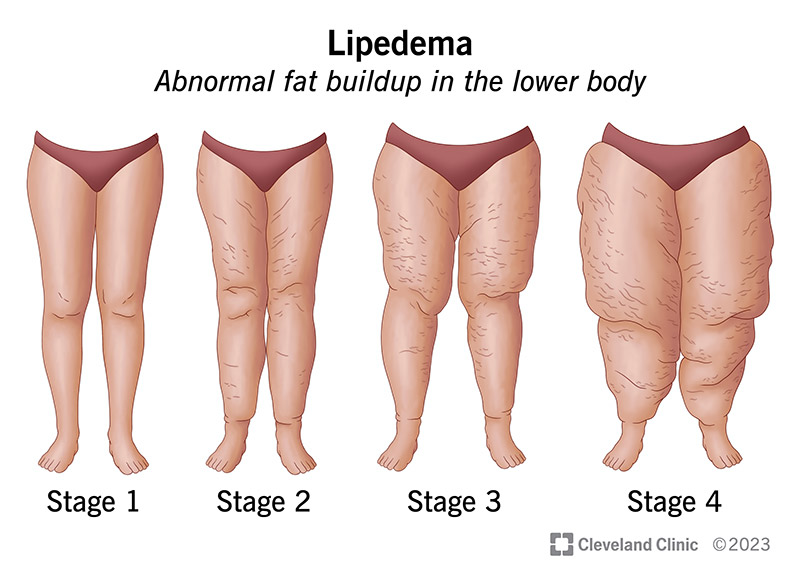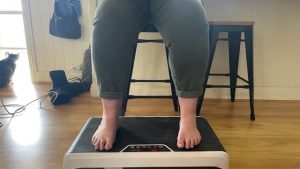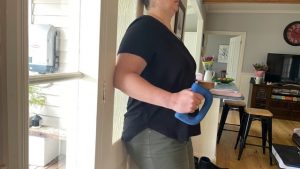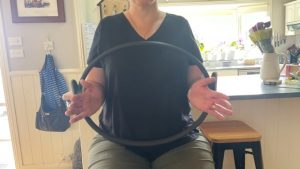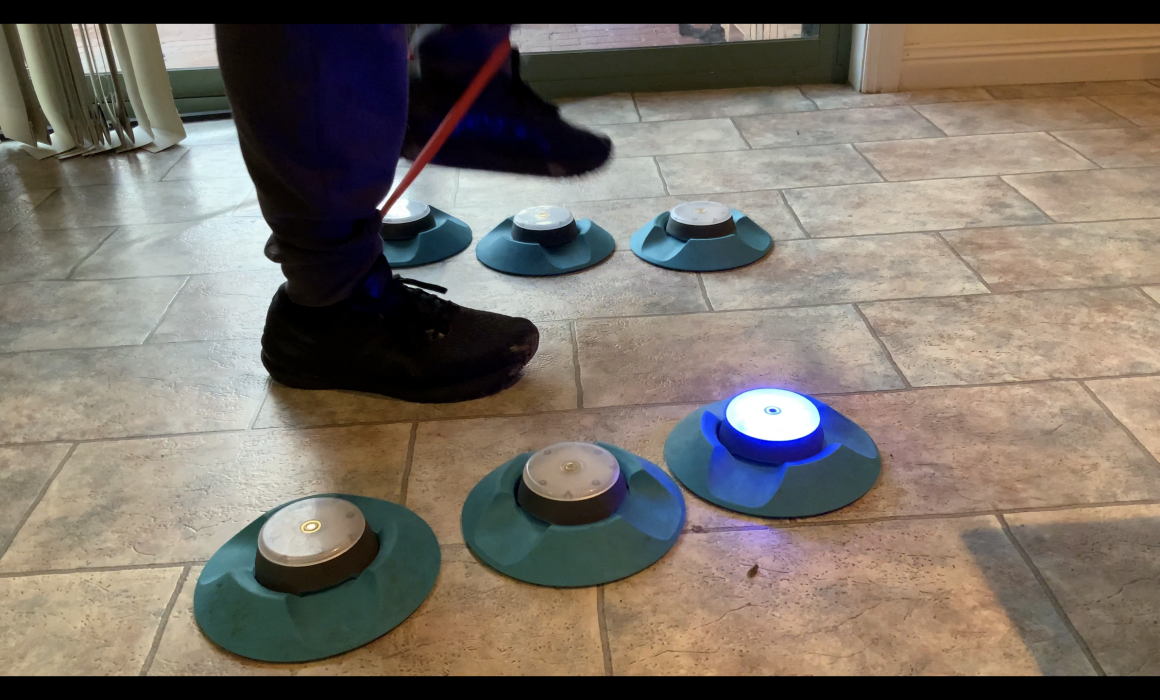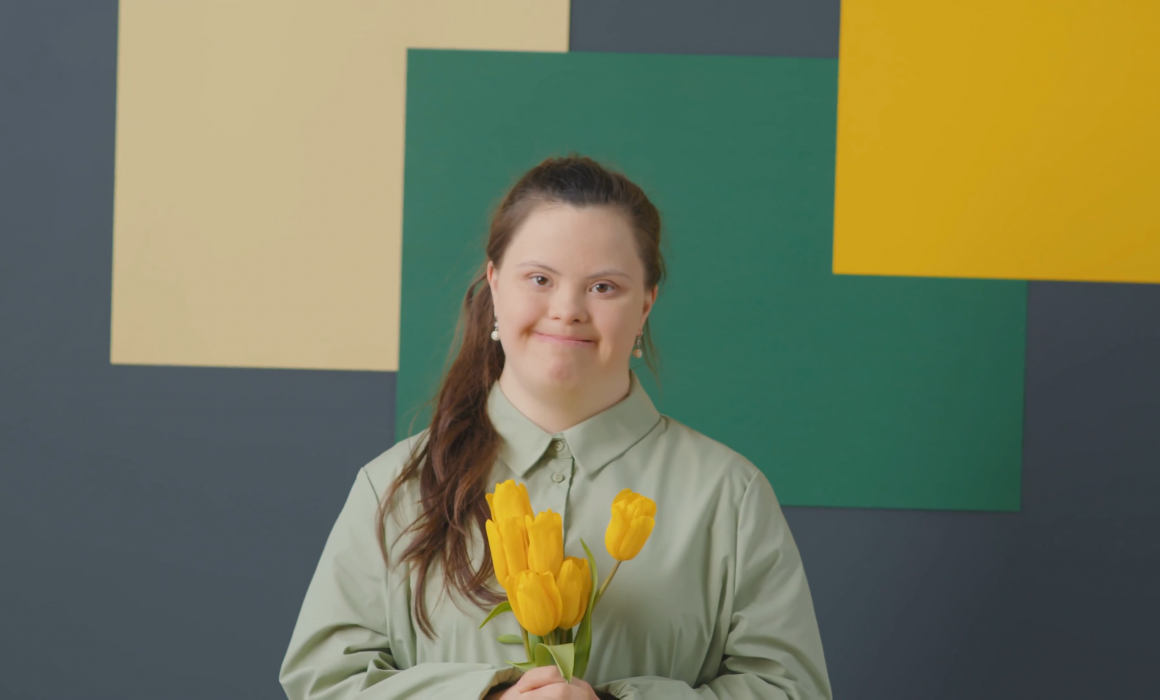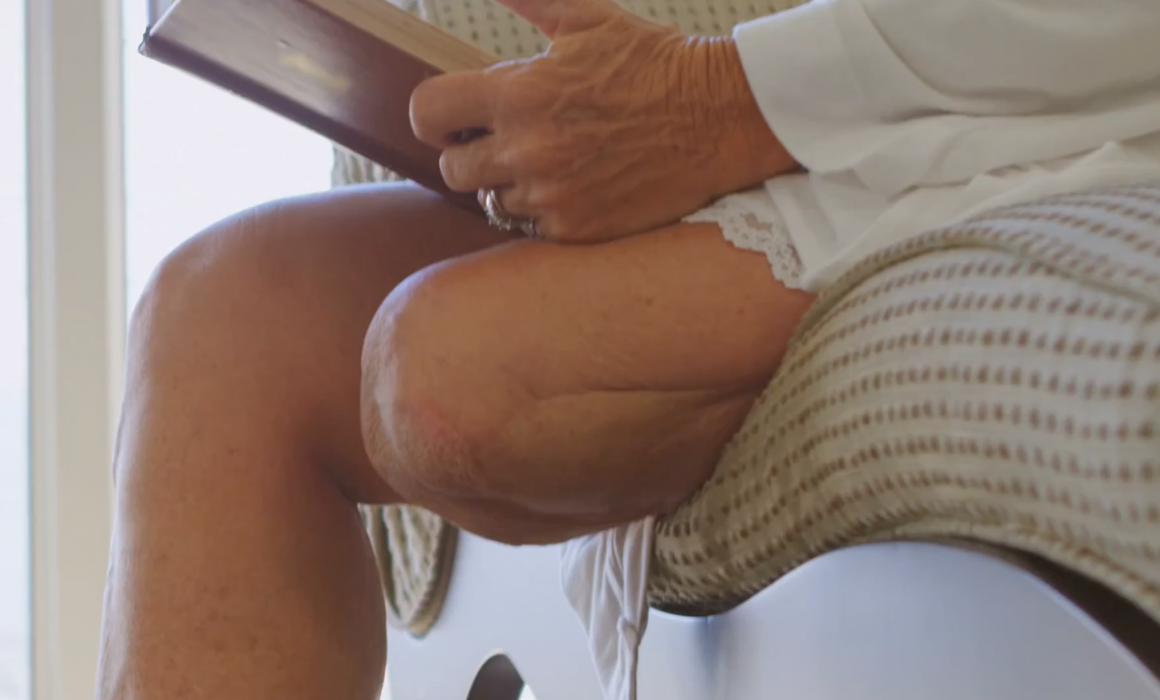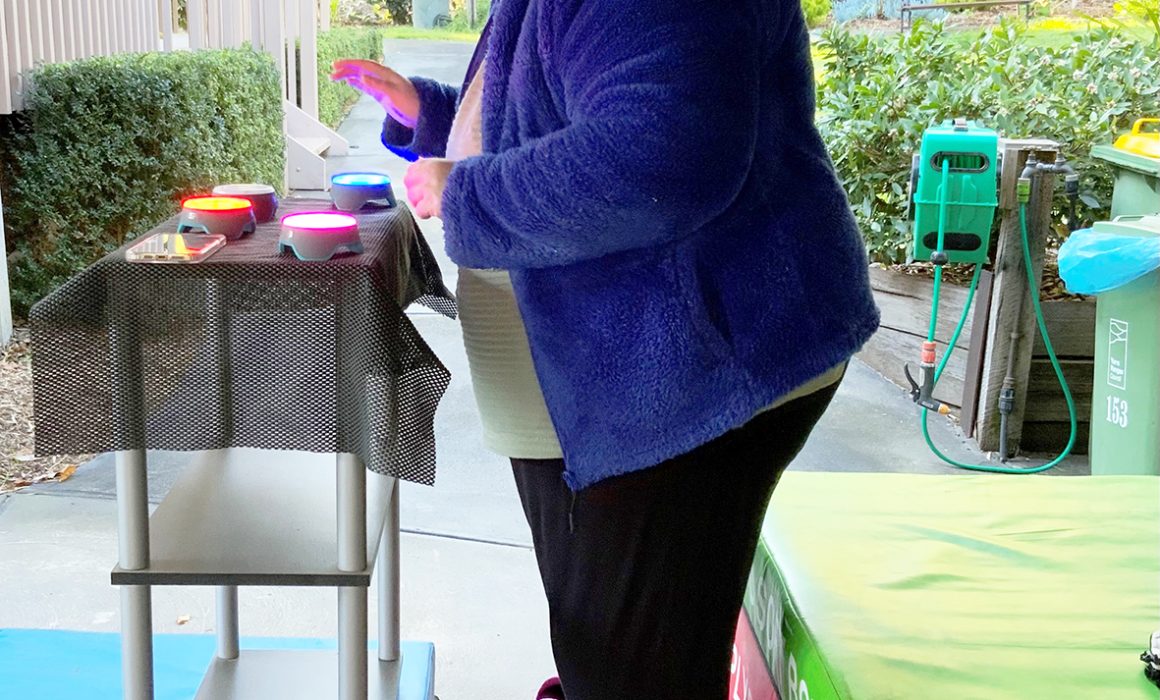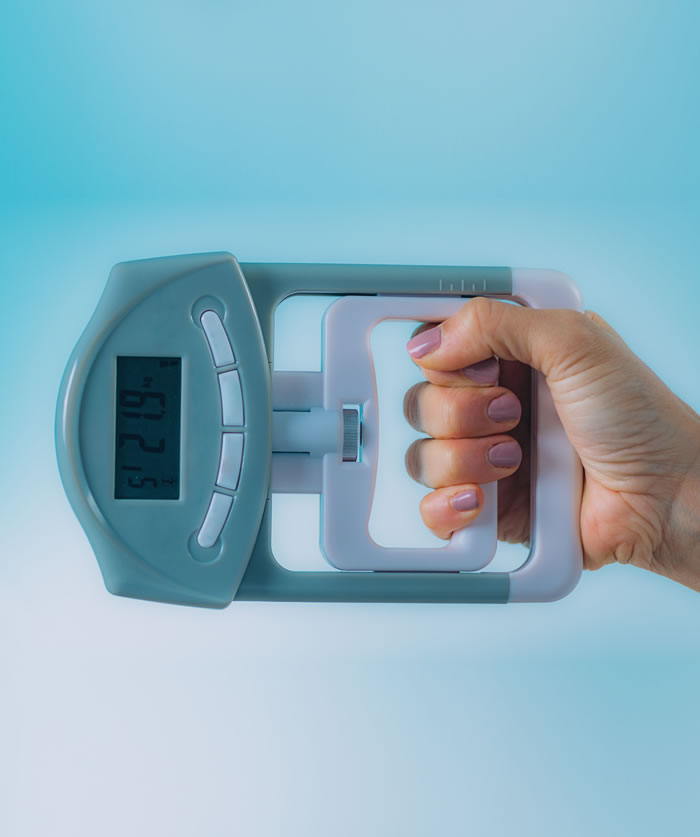Exercises for Lipedema
Understanding Lipedema
Lipedema, often overlooked and misunderstood, is a chronic condition characterized by abnormal fat deposition and swelling, primarily affecting the lower body and arms, particularly in women (Poojari et al., 2022). It is a medical condition different from obesity or Lymphedema (though it can be tagged along with those) in how it impacts a person’s mental health, mobility, and quality of life. Individuals suffering from lipedema explain it as, “It is like your body is playing a cruel trick on you, stacking up fat in all the wrong places. “One young woman said, “Think hips, thighs, and butt – while leaving other parts like the trunk, hands, and feet alone.” The weight gain is downright uncomfortable, causing pain sensations such as dullness, heaviness, or stabbing, often described as allodynia (pain due to a stimulus that does not normally provoke pain), where some women explain that even the lightness of touch can be very painful. While the exact mechanisms of pain in lipedema are still being studied, hormonal fluctuations, sympathetic nervous system activity, and altered neurotransmitter levels may play a role (Aksoy et al., 2020).
Lipedema progresses through three stages, each characterized by specific symptoms and manifestations (Poojari et al., 2022). In the initial stage, individuals may notice subtle changes such as mild swelling and the development of small nodules under the skin. As the condition progresses to stage II, the swelling becomes more pronounced, with visible indentations and palpable nodules. Finally, stage III is marked by severe swelling, increased pain, and mobility issues due to fibrotic changes in the adipose tissue. Unfortunately, it is more common in women, especially as they age, and research suggests that hormones play a large part (Poojari et al., 2022; Herbst et al., 2021). Hormonal fluctuations during puberty, pregnancy, or menopause can exacerbate symptoms, leading to increased swelling and discomfort. Although lipedema predominantly affects women, cases have been reported in men, often associated with hormonal imbalances (Herbst et al., 2021)
Why Exercise?
Because it helps and will make you feel better, and you are the most critical person. Exercise gives you the power to take back some control of how your body feels and, in some strange way, gives you the confidence to beat this. Please remember that exercise is not a cure for lipedema but will help you manage your symptoms and improve your health and well-being.
Exercise is essential for the following reasons: it helps improve lymphatic flow, reduce inflammation, improve joint strength, burn calories, and prevent muscle loss. The benefits of exercise around maintaining good health have long been proven, but when traditional forms of exercise are not possible for lipedema suffers from multiple co-morbidities (e.g., lymphedema with obesity or traumatic injuries), it becomes more important to find forms of exercise or activities to gain similar effects. Several studies and websites, such as Lipedema Facebook Group, where people suffering from this disease can share their experiences, and Total Lipedema Care, suggest the best lipedema exercise types are low-impact, gentle, consistent, steady, and state activities over a designated period. As an EP, I avoid prescribing high-impact or strenuous exercise as this can increase pain, fatigue, and lactic acid build-up in the muscles. Low-impact exercises will protect the joints, reduce pain stimulation, and improve lymphatic flow while reducing stress on the body. Examples of low-impact exercises are whole-body vibration, walking with short rest breaks, recumbent cycling on low resistance, swimming laps or treading water, water aerobics in deep water, and stretching.
The Best Exercises for Lipedema
Several beautiful exercises will complement other conservative treatments for lipedema, e.g., compression garments, manual lymphatic drainage massages, compression pumps, etc., that will help prepare any individual for any surgical treatments (pre- and post-recovery).
A 30-minute walk twice a week or swimming laps is a great place to augment exercise or as an exercise surrogate. However, if you are a person who wants to try something more progressive, then whole body vibration (WBV) protocols might be for you. This approach offers a viable treatment option to help attenuate inflammation, improve circulation, and increase stem/progenitor cell circulation levels associated with vascular health and improved functional outcomes (Jawed et al., 2020). If you cannot get on a vibration platform, you can start with a recumbent cycle on low resistance. Recumbent cycling places your legs parallel to the ground during the activity, like swimming, and the recumbent cycle helps venous return.
Whole Body Vibration
Whole Body Vibration (WBV) for lipedema at a frequency of 10 -15 hertz per minute (Rittweger, 2010) offers many benefits for individuals seeking to enhance their health and well-being. This nonpharmacological approach is particularly advantageous for those who struggle with activity levels or have difficulty tolerating traditional forms of exercise. WBV used with compression stockings has been shown to significantly help circulation throughout the body, delivering oxygen and nutrients to tissues while facilitating the removal of metabolic waste products (Jawed et al., 2020). Additionally, WBV stimulates bone remodeling processes, leading to increased bone density and strength, which is especially beneficial for individuals at risk of osteoporosis or those seeking to mitigate age-related bone loss. This is an essential consideration for lipedema sufferers, as exercise loading in the traditional sense is not possible.
Furthermore, the gentle vibrations generated by WBV have been found to reduce pain levels, making it an attractive option for individuals managing allodynia (V.G.C. Ribeiro et al., 2017). WBV can improve overall function and mobility by promoting muscle relaxation and reducing muscle tension. WBV provides these benefits while minimizing joint stress and cardiovascular demands, making it suitable for individuals with lower-body osteoarthritis or cardiovascular limitations (Rittweger, 2010). Overall, WBV offers a safe, effective, and accessible means of improving circulation, increasing bone density, reducing pain, and enhancing functional capacity for a diverse range of individuals (Jawed et al., 2020; V.G.C. Ribeiro et al., 2017; Rittweger, 2010).
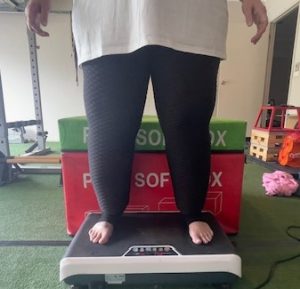
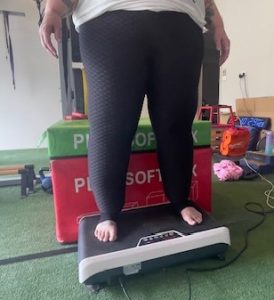
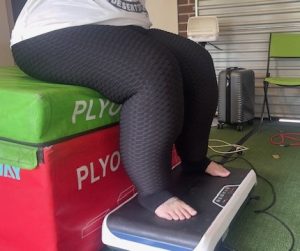
Swimming Laps
Swimming laps and treading water with flippers are dynamic exercises that offer many benefits for physical and mental well-being. These activities improve circulation throughout the body by engaging multiple muscle groups in the upper and lower body while promoting efficient blood flow. Additionally, the rhythmic movement involved in swimming and treading water enhances the heart’s contractility, improving cardiovascular health and endurance. For individuals with lipedema, the buoyancy of treading water reduces the impact on joints, alleviating pain and stiffness while allowing for a broader range of motion. Even better when it comes to mental health, swimming stimulates the production of brain-derived neurotrophic factor (BDNF), a protein that supports neurogenesis and enhances cognitive function (Just-Borràs et al., 2021). Beyond the physical benefits, swimming activities also contribute to mental well-being by triggering the release of endorphins, which act as natural painkillers and mood enhancers. The immersive nature of swimming promotes relaxation, reduces stress levels, and boosts self-esteem, ultimately fostering a sense of mental clarity and emotional resilience.
The Advantages of Jogging and Treading Water (with Fins) for Lipedema Management
Submerging oneself in water deeper than 4 feet introduces hydrostatic pressure, surpassing diastolic blood pressure and mitigating effusion or swelling observed in individuals with lipedema. The hydrostatic pressure stems from Pascal’s law, stating that the pressure exerted by a fluid at any depth is uniform on all submerged surfaces. Hydrostatic pressure escalates as one descends further into the water, increasing by 22.4mmHg for every foot of depth. Consequently, by treading water at 4 feet of water depth, the hydrostatic pressure amounts to 89.6 mm Hg, marginally surpassing typical diastolic blood pressure levels (James et al., 2012).
Hydrostatic pressure and leg kicking’s cyclic action augments venous return and cardiac functions, facilitating the expulsion of lactic acid from the lower extremities and enhancing blood circulation back to the heart, thereby diminishing cardiac workload. Moreover, water pressure can alleviate swelling in afflicted joints or limbs. Enhanced circulation, because of aquatic exercise, aids in efficient waste product removal from the body, consequently mitigating post-workout muscle soreness.
Treading water enables individuals to exert themselves more strenuously without undue strain on the cardiovascular system. The inherent resistance water offers against leg movements challenges muscles while minimizing joint stress, culminating in a robust, gentle workout regime on the cardiovascular system. Consequently, achieving comparable workout benefits with reduced heart rate signifies a more resourceful training methodology, particularly advantageous for individuals with cardiovascular or osteoarthritis ailments.
13-Week Exercise Program
13-week program (52 weeks / 4 = 13 weeks)
Weeks 1 to 4
Kick off with two 30-minute weekly sessions, focusing on gradually increasing the intensity. By that, I mean walking a little quicker and covering more distances, swimming a little faster each week, and, if you are cycling, using a recumbent bike. Start RPMs at 40 and increase to 50 on a meager resistance, avoiding forcefully pushing of the pedals.
Weeks 5 – 8
Maintain the 35-40-minute sessions while aiming to push your boundaries further. Repeat weeks 1-4 regarding intensity. Gradual progression is based on your comfort and pain tolerance. You might find yourself doing three sets of 10-minute reps with short breaks. Listening to your body and taking breaks to prevent overexertion is crucial.
Weeks 9 to 12
Maintain 40- 50-minute sessions. You will swim faster or for longer, cycle with increased speed, and feel your heart rate rise as you push yourself to new limits. Embrace the challenge, knowing your dedication will improve your fitness and overall well-being.
Week 13 Rest
Take the entire week off from structured exercise to allow your body to rest and recover fully.
Thanks for reading, Cheers Chris
References
Aksoy, H., Karadag, A. S., & Wollina, U. (2020, September 27). Cause and management of lipedema-associated pain. Dermatology Therapy. doi:DOI: 10.1111/dth.14364
Ankita Poojari, K. D. (2022, November 30). Lipedema: Insights into Morphology, Pathophysiology, and Challenges. Biomedicines. doi:doi.org/10.3390/biomedicines10123081
Herbst, K. L., Kahn, L. A., Iker, E., Ehrlich, C., Wright, T., McHutchison, L., . . . MC Donahue, P. (2021). Standard of care for lipedema in the United States. Phlebology, Vol. 36(10), 779–796. doi:DOI: 10.1177/02683555211015887
James R. Andrews, G. L.-N. (2012). Physical Rehabilitation of the Injured Athlete (Fourth Edition),. Aqua Rehabilitation
Jawed, Y., Beli, E., March, K., Kaleth, A., & Loghmani, T. (2020). Whole-body vibration Training Increases Stem/Progenitor Cell Circulation Levels and May Attenuate Inflammation. MILITARY MEDICINE, 185, 404–412.
Just-Borràs, L., Cilleros-Mañé, V., Hurtado, E., Biondi, O., Charbonnier, F., Tomàs, M., . . . Lanuza, M. A. (2021,, April 27). Running and Swimming Differently Adapt the BDNF/TrkB Pathway to a Slow Molecular Pattern at the NMJ. International Journal of Molecular Sciences, 1-20. doi:10.3390/ijms22094577
Rittweger, J. (2010). Vibration as an exercise modality: how it may work, and its potential. Eur J Appl Physiol, 108:877–904. doi: 10.1007/s00421-009-1303-3
V.G.C. Ribeiro, V. M. (2017, December 18). Inflammatory biomarkers responses after acute whole body vibration in fibromyalgia. Journal of Medical and Biological Research, 1-9. doi:10.1590/1414-431X20176775

